Lessons from Inter-Comparison of Decadal Climate Simulations and Observations for the Midwest U.S. and Great Lakes Region
Abstract
1. Introduction
2. Methods
2.1. Gridded Observations
2.2. NARR Datasets
2.3. WRF Model Implementation
2.4. Experimental Design
3. Results
3.1. Gridded Observations
3.2. NARR Datasets
3.3. WRF Model Simulations
3.4. Inter-Comparison among all Datasets
4. Discussion and Conclusions
Supplementary Materials
Author Contributions
Funding
Acknowledgments
Conflicts of Interest
References
- Gerbush, M.R.; Kristovich, D.A.R.; Laird, N.F. Mesoscale Boundary Layer and Heat Flux Variations over Pack Ice–Covered Lake Erie. J. Appl. Meteorol. Climatol. 2008, 47, 668–682. [Google Scholar] [CrossRef]
- Schoof, J. 11. Historical and projected changes in human heat stress in the Midwestern United States. In Climate Change in The Midwest: Impacts, Risks, Vulnerability, And Adaptation; Indiana University Press: Bloomington, IN, USA, 2013; Volume 146, pp. 146–157. [Google Scholar]
- Zobel, Z.; Wang, J.; Wuebbles, D.J.; Kotamarthi, V.R. High-resolution dynamical downscaling ensemble projections of future extreme temperature distributions for the United States. Earths Future 2017, 5, 1234–1251. [Google Scholar] [CrossRef]
- Zobel, Z.; Wang, J.; Wuebbles, D.J.; Kotamarthi, V.R. Analyses for High-Resolution Projections Through the End of the 21st Century for Precipitation Extremes Over the United States. Earths Future 2018, 6, 1471–1490. [Google Scholar] [CrossRef]
- USGCRP. Impacts, Risks, and Adaptation in the United States: Fourth National Climate Assessment; U.S. Global Change Research Program: Washington, DC, USA, 2018; Volume II, p. 1515. Available online: https://nca2018.globalchange.gov/downloads/NCA4_Ch01_Overview.pdf (accessed on 21 April 2019).
- Changnon, S.A. Impacts of 1997–98 EI Niño–Generated Weather in the United States. Bull. Am. Meteorol. Soc. 1999, 80, 1819–1828. [Google Scholar] [CrossRef]
- Meehl, G.A.; Tebaldi, C. More intense, more frequent, and longer lasting heat waves in the 21st century. Science 2004, 305, 994–997. [Google Scholar] [CrossRef]
- Easterling, D.R. Climate Extremes: Observations, Modeling, and Impacts. Science 2000, 289, 2068–2074. [Google Scholar] [CrossRef]
- Wuebbles, D.; Cardinale, B.; Cherkauer, K.; Davidson-Arnott, R.; Hellmann, J.J.; Infante, D.; Johnson, L.; de Loe, R.; Lofgren, B.; Packman, A.; et al. An Assessment of the Impacts of Climate Change on the Great Lakes; The Environmental Law & Policy Center: Chicago, IL, USA, 2019; Available online: http://elpc.org/glclimatechange/ (accessed on 21 April 2019).
- Carpenter, S.R.; Booth, E.G.; Kucharik, C.J. Extreme precipitation and phosphorus loads from two agricultural watersheds. Limnol. Oceanogr. 2018, 63, 1221–1233. [Google Scholar] [CrossRef]
- Kelly, S.A.; Takbiri, Z.; Belmont, P.; Foufoula-Georgiou, E. Human amplified changes in precipitation–runoff patterns in large river basins of the Midwestern United States. Hydrol. Earth Syst. Sci. 2017, 21, 5065–5088. [Google Scholar] [CrossRef]
- USGCRP. Climate Science Special Report: Fourth National Climate Assessment; U.S. Global Change Research Program: Washington, DC, USA, 2017; Volume I, p. 475.
- Byun, K.; Hamlet, A.F. Projected changes in future climate over the Midwest and Great Lakes region using downscaled CMIP5 ensembles. Int. J. Climatol. 2018, 38, e531–e553. [Google Scholar] [CrossRef]
- Intergovernmental Panel on Climate Change. Climate Change 2007—The Physical Science Basis: Working Group I Contribution to the Fourth Assessment Report of the IPCC; Cambridge University Press: Cambridge, UK, 2007; ISBN 9780521880091. [Google Scholar]
- Sharma, A.; Hamlet, A.F.; Fernando, H.J.S.; Catlett, C.E.; Horton, D.E.; Kotamarthi, V.R.; Kristovich, D.A.R.; Packman, A.I.; Tank, J.L.; Wuebbles, D.J. The Need for an Integrated Land-Lake-Atmosphere Modeling System, Exemplified by North America’s Great Lakes Region. Earths Future 2018, 6, 1366–1379. [Google Scholar] [CrossRef]
- Byun, K.; Chiu, C.-M.; Hamlet, A.F. Effects of 21st century climate change on seasonal flow regimes and hydrologic extremes over the Midwest and Great Lakes region of the US. Sci. Total Environ. 2019, 650, 1261–1277. [Google Scholar] [CrossRef]
- Hamlet, A.F.; Chiu, C.M.; Sharma, A.; Byun, K.; Hanson, Z. Developing Flexible, Integrated Hydrologic Modeling Systems for Multiscale Analysis in the Midwest and Great Lakes Region. In Proceedings of the AGU Fall Meeting, San Francisco, CA, USA, 12–16 December 2016. [Google Scholar]
- Keeley, M.; Koburger, A.; Dolowitz, D.P.; Medearis, D.; Nickel, D.; Shuster, W. Perspectives on the use of green infrastructure for stormwater management in Cleveland and Milwaukee. Environ. Manage. 2013, 51, 1093–1108. [Google Scholar] [CrossRef]
- Sharma, A.; Conry, P.; Fernando, H.J.S.; Hamlet, A.F.; Hellmann, J.J.; Chen, F. Green and cool roofs to mitigate urban heat island effects in the Chicago metropolitan area: Evaluation with a regional climate model. Environ. Res. Lett. 2016, 11, 064004. [Google Scholar] [CrossRef]
- Sharma, A.; Fernando, H.J.S.; Hamlet, A.F.; Hellmann, J.J.; Barlage, M.; Chen, F. Urban meteorological modeling using WRF: A sensitivity study. Int. J. Climatol. 2017, 37, 1885–1900. [Google Scholar] [CrossRef]
- Sharma, A.; Woodruff, S.; Budhathoki, M.; Hamlet, A.F.; Chen, F.; Fernando, H.J.S. Role of green roofs in reducing heat stress in vulnerable urban communities—A multidisciplinary approach. Environ. Res. Lett. 2018, 13, 094011. [Google Scholar] [CrossRef]
- Sharma, A.; Fernando, H.J.S.; Hellmann, J.; Chen, F. Sensitivity of WRF Model to Urban Parameterizations, With Applications to Chicago Metropolitan Urban Heat Island. In Proceedings of the ASME 2014 4th Joint US-European Fluids Engineering Division Summer Meeting collocated with the ASME 2014 12th International Conference on Nanochannels, Microchannels, and Minichannels, Chicago, IL, USA, 3–7 August 2014. [Google Scholar]
- Conry, P.; Fernando, H.J.S.; Leo, L.S.; Sharma, A.; Potosnak, M.; Hellmann, J. Multi-Scale Simulations of Climate-Change Influence on Chicago Heat Island. In Proceedings of the ASME 2014 4th Joint US-European Fluids Engineering Division Summer Meeting collocated with the ASME 2014 12th International Conference on Nanochannels, Microchannels, and Minichannels, Chicago, IL, USA, 3–7 August 2014. [Google Scholar]
- Conry, P.; Sharma, A.; Potosnak, M.J.; Leo, L.S.; Bensman, E.; Hellmann, J.J.; Fernando, H.J.S. Chicago’s heat island and climate change: Bridging the scales via dynamical downscaling. J. Appl. Meteorol. Climatol. 2015, 54, 1430–1448. [Google Scholar] [CrossRef]
- Silva, M.P.; Sharma, A.; Budhathoki, M.; Jain, R.; Catlett, C.E. Neighborhood scale heat mitigation strategies using Array of Things (AoT) data in Chicago. In Proceedings of the AGU Fall Meeting, Washington, DC, USA, 10–14 December 2018. [Google Scholar]
- Sharma, A.; Woodruff, S.; Budhathoki, M.; Hamlet, A.F.; Fernando, H.J.S.; Chen, F. Can green roofs reduce urban heat stress in vulnerable urban communities: A coupled atmospheric and social modeling approach. In Proceedings of the AGU Fall Meeting, New Orleans, LA, USA, 11–15 December 2017. [Google Scholar]
- Bunnell, D.B.; Barbiero, R.P.; Ludsin, S.A.; Madenjian, C.P.; Warren, G.J.; Dolan, D.M.; Brenden, T.O.; Briland, R.; Gorman, O.T.; He, J.X.; et al. Changing Ecosystem Dynamics in the Laurentian Great Lakes: Bottom-Up and Top-Down Regulation. Bioscience 2014, 64, 26–39. [Google Scholar] [CrossRef]
- Goodspeed, R.; Riseng, C.; Wehrly, K.; Yin, W.; Mason, L.; Schoenfeldt, B. Applying design thinking methods to ecosystem management tools: Creating the Great Lakes Aquatic Habitat Explorer. Mar. Policy 2016, 69, 134–145. [Google Scholar] [CrossRef]
- Lubchenco, J.; Sutley, N. Proposed U.S. Policy for Ocean, Coast, and Great Lakes Stewardship. Science 2010, 328, 1485–1486. [Google Scholar] [CrossRef]
- Sierszen, M.E.; Morrice, J.A.; Trebitz, A.S.; Hoffman, J.C. A review of selected ecosystem services provided by coastal wetlands of the Laurentian Great Lakes. Aquat. Ecosyst. Health Manag. 2012, 15, 92–106. [Google Scholar] [CrossRef]
- Mueller, N.D.; Butler, E.E.; McKinnon, K.A.; Rhines, A.; Tingley, M.; Holbrook, N.M.; Huybers, P. Cooling of US Midwest summer temperature extremes from cropland intensification. Nat. Clim. Chang. 2015, 6, 317. [Google Scholar] [CrossRef]
- Goswami, B.B.; Mukhopadhyay, P.; Khairoutdinov, M.; Goswami, B.N. Simulation of Indian summer monsoon intraseasonal oscillations in a superparameterized coupled climate model: need to improve the embedded cloud resolving model. Clim. Dyn. 2013, 41, 1497–1507. [Google Scholar] [CrossRef]
- Wehner, M.F.; Smith, R.L.; Bala, G.; Duffy, P. The effect of horizontal resolution on simulation of very extreme US precipitation events in a global atmosphere model. Clim. Dyn. 2010, 34, 241–247. [Google Scholar] [CrossRef]
- Kendon, E.J.; Roberts, N.M.; Senior, C.A.; Roberts, M.J. Realism of Rainfall in a Very High-Resolution Regional Climate Model. J. Clim. 2012, 25, 5791–5806. [Google Scholar] [CrossRef]
- Bukovsky, M.S.; Karoly, D.J. A Regional Modeling Study of Climate Change Impacts on Warm-Season Precipitation in the Central United States. J. Clim. 2011, 24, 1985–2002. [Google Scholar] [CrossRef]
- Parmesan, C.; Root, T.L.; Willig, M.R. Impacts of Extreme Weather and Climate on Terrestrial Biota. Bull. Am. Meteorol. Soc. 2000, 81, 443–450. [Google Scholar] [CrossRef]
- Parmesan, C.; Martens, P. Climate change, wildlife, and human health. Biodiversity Change and Human Health: From Ecosystem Services to Spread of Disease. 2009, 69, 245–266. [Google Scholar]
- Castro, C.L.; Pielke, R.A., Sr. Dynamical downscaling: Assessment of value retained and added using the Regional Atmospheric Modeling System (RAMS). J. Geophys. Res. 2005. [Google Scholar] [CrossRef]
- Pielke, R.A., Sr.; Wilby, R.L. Regional climate downscaling: What’s the point? Eos Trans. AGU 2012, 93, 52–53. [Google Scholar] [CrossRef]
- Pielke, R. Comments on “The North American Regional Climate Change Assessment Program: Overview of Phase I Results”. Bull. Am. Meteorol. Soc. 2013, 94, 1075–1077. [Google Scholar] [CrossRef]
- Mearns, L.O.; Bukovsky, M.S.; Leung, R.; Qian, Y.; Arritt, R.; Gutowski, W.; Takle, E.S.; Biner, S.; Caya, D.; Correia, J.; et al. Reply to “Comments on ‘The North American Regional Climate Change Assessment Program: Overview of Phase I Results’”. Bull. Am. Meteorol. Soc. 2013, 94, 1077–1078. [Google Scholar] [CrossRef]
- Rockel, B.; Castro, C.L.; Pielke, R.A., Sr.; von Storch, H.; Leoncini, G. Dynamical downscaling: Assessment of model system dependent retained and added variability for two different regional climate models. J. Geophys. Res. 2008, 113, D05108. [Google Scholar] [CrossRef]
- Wang, J.; Kotamarthi, V.R. Assessment of Dynamical Downscaling in Near-Surface Fields with Different Spectral Nudging Approaches Using the Nested Regional Climate Model (NRCM). J. Appl. Meteorol. Climatol. 2013, 52, 1576–1591. [Google Scholar] [CrossRef]
- Pielke, R.A. A Recommended Specific Definition of “Resolution”. Bull. Am. Meteorol. Soc. 1991, 72, 1914. [Google Scholar] [CrossRef]
- Pielke, R.A. Further Comments on “The Differentiation between Grid Spacing and Resolution and Their Application to Numerical Modeling”. Bull. Am. Meteorol. Soc. 2001, 82, 699–700. [Google Scholar] [CrossRef][Green Version]
- Laprise, R. The resolution of global spectral models. Bull. Am. Meteorol. Soc. 1992, 73, 1453–1455. [Google Scholar] [CrossRef][Green Version]
- Pielke, R.A., Sr. Mesoscale Meteorological Modeling; Academic Press: Cambridge, MA, USA, 2013; ISBN 9780123852380. [Google Scholar]
- Kalnay, E.; Kanamitsu, M.; Kistler, R.; Collins, W.; Deaven, D.; Gandin, L.; Iredell, M.; Saha, S.; White, G.; Woollen, J.; et al. The NCEP/NCAR 40-Year Reanalysis Project. Bull. Am. Meteorol. Soc. 1996, 77, 437–472. [Google Scholar] [CrossRef]
- Maurer, E.P.; Wood, A.W.; Adam, J.C.; Lettenmaier, D.P.; Nijssen, B. A Long-Term Hydrologically Based Dataset of Land Surface Fluxes and States for the Conterminous United States. J. Clim. 2002, 15, 3237–3251. [Google Scholar] [CrossRef]
- Hamlet, A.F.; Lettenmaier, D.P. Production of Temporally Consistent Gridded Precipitation and Temperature Fields for the Continental United States. J. Hydrometeorol. 2005, 6, 330–336. [Google Scholar] [CrossRef]
- Shepard, D.S. Computer Mapping: The SYMAP Interpolation Algorithm. Spat. Stat. Models 1984, 40, 133–145. [Google Scholar]
- World Meteorological Organization. Guide to Meteorological Instruments and Methods of Observation; Secretariat of the World Meteorological Organization: Geneva, Switzerland, 1983. [Google Scholar]
- Yang, D.; Goodison, B.E.; Metcalfe, J.R.; Golubev, V.S.; Bates, R.; Pangburn, T.; Hanson, C.L. Accuracy of NWS 8″ Standard Nonrecording Precipitation Gauge: Results and Application of WMO Intercomparison. J. Atmos. Ocean. Technol. 1998, 15, 54–68. [Google Scholar] [CrossRef]
- Mekis, É.; Vincent, L.A. An Overview of the Second Generation Adjusted Daily Precipitation Dataset for Trend Analysis in Canada. Atmosphere Ocean 2011, 49, 163–177. [Google Scholar] [CrossRef]
- Mesinger, F.; DiMego, G.; Kalnay, E.; Mitchell, K.; Shafran, P.C.; Ebisuzaki, W.; Jović, D.; Woollen, J.; Rogers, E.; Berbery, E.H.; et al. North American Regional Reanalysis. Bull. Am. Meteorol. Soc. 2006, 87, 343–360. [Google Scholar] [CrossRef]
- Lo, J.C.-F.; Yang, Z.-L.; Pielke, R.A., Sr. Assessment of three dynamical climate downscaling methods using the Weather Research and Forecasting (WRF) model. J. Geophys. Res. 2008, 113, 1306. [Google Scholar] [CrossRef]
- Skamarock, W.C.; Klemp, J.B.; Dudhia, J.; Gill, D.O.; Barker, D.M.; Wang, W.; Powers, J.G. A Description of the Advanced Research WRF Version 2. 2005. Available online: http://opensky.ucar.edu/islandora/object/technotes:479 (accessed on 21 April 2019).
- Heikkilä, U.; Sandvik, A.; Sorteberg, A. Dynamical downscaling of ERA-40 in complex terrain using the WRF regional climate model. Clim. Dyn. 2011, 37, 1551–1564. [Google Scholar] [CrossRef]
- Sharma, A.; Huang, H.-P. Regional Climate Simulation for Arizona: Impact of Resolution on Precipitation. Adv. Meteorol. 2012, 2012, 505726. [Google Scholar] [CrossRef]
- Talbot, C.; Bou-Zeid, E.; Smith, J. Nested Mesoscale Large-Eddy Simulations with WRF: Performance in Real Test Cases. J. Hydrometeorol. 2012, 13, 1421–1441. [Google Scholar] [CrossRef]
- Pithani, P.; Ghude, S.D.; Chennu, V.N.; Kulkarni, R.G.; Steeneveld, G.-J.; Sharma, A.; Prabhakaran, T.; Chate, D.M.; Gultepe, I.; Jenamani, R.K.; et al. WRF Model Prediction of a Dense Fog Event Occurred During the Winter Fog Experiment (WIFEX). Pure Appl. Geophys. 2018, 176. [Google Scholar] [CrossRef]
- Sharma, A.; Huang, H.-P.; Zavialov, P.; Khan, V. Impact of Desiccation of Aral Sea on the Regional Climate of Central Asia Using WRF Model. Pure Appl. Geophys. 2018, 175, 465–478. [Google Scholar] [CrossRef]
- Conry, P.; Sharma, A.; Leo, L.; Fernando, H.J.S.; Potosnak, M.; Hellmann, J. Modeling and measuring neighborhood scale flow, turbulence, and temperature within Chicago heat island. In Proceedings of the APS Division of Fluid Dynamics Meeting, Pittsburgh, PA, USA, 24–26 November 2013. [Google Scholar]
- Kanamitsu, M.; Ebisuzaki, W.; Woollen, J.; Yang, S.-K.; Hnilo, J.J.; Fiorino, M.; Potter, G.L. NCEP-DOE Amip-II Reanalysis (R-2). Bull. Am. Meteorol. Soc. 2002, 83, 1631–1644. [Google Scholar] [CrossRef]
- Fry, J.; Xian, G.Z.; Jin, S.; Dewitz, J.; Homer, C.G.; Yang, L.; Barnes, C.A.; Herold, N.D.; Wickham, J.D. Completion of the 2006 national land cover database for the conterminous United States. Photogramm. Eng. Remote Sens. 2011, 77, 858–864. [Google Scholar]
- Hong, S.-Y.; Lim, J.-O.J. The WRF single-moment 6-class microphysics scheme (WSM6). Asia Pac. J. Atmos. Sci. 2006, 42, 129–151. [Google Scholar]
- Dudhia, J. Numerical Study of Convection Observed during the Winter Monsoon Experiment Using a Mesoscale Two-Dimensional Model. J. Atmos. Sci. 1989, 46, 3077–3107. [Google Scholar] [CrossRef]
- Mlawer, E.J.; Taubman, S.J.; Brown, P.D.; Iacono, M.J.; Clough, S.A. Radiative transfer for inhomogeneous atmospheres: RRTM, a validated correlated-k model for the longwave. J. Geophys. Res. Atmos. 1997, 102, 16663–16682. [Google Scholar] [CrossRef]
- Noh, Y.; Cheon, W.G.; Hong, S.Y.; Raasch, S. Improvement of the K-profile Model for the Planetary Boundary Layer based on Large Eddy Simulation Data. Bound. Layer Meteorol. 2003, 107, 401–427. [Google Scholar] [CrossRef]
- Chen, F.; Dudhia, J. Coupling an Advanced Land Surface–Hydrology Model with the Penn State–NCAR MM5 Modeling System. Part I: Model Implementation and Sensitivity. Mon. Weather Rev. 2001, 129, 569–585. [Google Scholar] [CrossRef]
- Kain, J.S. The Kain–Fritsch Convective Parameterization: An Update. J. Appl. Meteorol. 2004, 43, 170–181. [Google Scholar] [CrossRef]
- Xiao, C.; Lofgren, B.M.; Wang, J. Improving the lake scheme within a coupled WRF-lake model in the Laurentian Great Lakes. JAMES 2016, 11. [Google Scholar] [CrossRef]
- Theeuwes, N.E.; Steeneveld, G.J.; Krikken, F.; Holtslag, A.A.M. Mesoscale modeling of lake effect snow over Lake Erie - sensitivity to convection, microphysics and the water temperature. Adv. Sci. Res. 2010, 2010, 15–22. [Google Scholar] [CrossRef][Green Version]
- Campbell, L.S.; Steenburgh, W.J. The OWLeS IOP2b Lake-Effect Snowstorm: Mechanisms Contributing to the Tug Hill Precipitation Maximum. Mon. Weather Rev. 2017, 145, 2461–2478. [Google Scholar] [CrossRef]
- McMillen, J.D.; Steenburgh, W.J. Capabilities and Limitations of Convection-Permitting WRF Simulations of Lake-Effect Systems over the Great Salt Lake. Weather Forecast. 2015, 30, 1711–1731. [Google Scholar] [CrossRef]
- Pan, Z.; Takle, E.; Gutowski, W.; Turner, R. Long Simulation of Regional Climate as a Sequence of Short Segments. Mon. Weather Rev. 1999, 127, 308–321. [Google Scholar] [CrossRef]
- Conil, S.; Hall, A. Local Regimes of Atmospheric Variability: A Case Study of Southern California. J. Clim. 2006, 19, 4308–4325. [Google Scholar] [CrossRef]
- Qian, J.-H.; Seth, A.; Zebiak, S. Reinitialized versus Continuous Simulations for Regional Climate Downscaling. Mon. Weather Rev. 2003, 131, 2857–2874. [Google Scholar] [CrossRef]
- Žagar, N.; Žagar, M.; Cedilnik, J.; Gregorič, G.; Rakovec, J. Validation of mesoscale low-level winds obtained by dynamical downscaling of ERA40 over complex terrain. Tellus Ser. A Dyn. Meteorol. Oceanogr. 2006, 58, 445–455. [Google Scholar] [CrossRef]
- Jiménez, P.A.; Fidel González-Rouco, J.; García-Bustamante, E.; Navarro, J.; Montávez, J.P.; de Arellano, J.V.-G.; Dudhia, J.; Muñoz-Roldan, A. Surface Wind Regionalization over Complex Terrain: Evaluation and Analysis of a High-Resolution WRF Simulation. J. Appl. Meteorol. Climatol. 2010, 49, 268–287. [Google Scholar] [CrossRef]
- Lucas-Picher, P.; Boberg, F.; Christensen, J.H.; Berg, P. Dynamical Downscaling with Reinitializations: A Method to Generate Finescale Climate Datasets Suitable for Impact Studies. J. Hydrometeorol. 2013, 14, 1159–1174. [Google Scholar] [CrossRef]
- Winkler, J.A.; Arritt, R.W.; Pryor, S.C. Climate Projections for the Midwest: Availability, Interpretation and Synthesis. US National Climate Assessment Midwest Technical Input Report. 2012. Available online: http://glisa.umich.edu/media/files/NCA/MTIT_Future.pdf (accessed on 21 April 2019).
- Rasmussen, R.; Ikeda, K.; Liu, C.; Gochis, D.; Chen, F.; Barlage, M.J.; Dai, A.; Dudhia, J.; Clark, M.P.; Gutmann, E.D.; et al. High Resolution Climate Modeling of the Water Cycle over the Contiguous United States Including Potential Climate Change Scenarios. 2015. Available online: https://www.gewexevents.org/wp-content/uploads/Rasmussen_CONUS_USRHP2016.pdf (accessed on 21 April 2019).
- Liu, C.; Ikeda, K.; Rasmussen, R.; Barlage, M.; Newman, A.J.; Prein, A.F.; Chen, F.; Chen, L.; Clark, M.; Dai, A.; et al. Continental-scale convection-permitting modeling of the current and future climate of North America. Clim. Dyn. 2017, 49, 71–95. [Google Scholar] [CrossRef]
- Schroeder, J.J.; Kristovich, D.A.R.; Hjelmfelt, M.R. Boundary Layer and Microphysical Influences of Natural Cloud Seeding on a Lake-Effect Snowstorm. Mon. Weather Rev. 2006, 134, 1842–1858. [Google Scholar] [CrossRef]
- Kristovich, D.A.R.; Clark, R.D.; Frame, J.; Geerts, B.; Knupp, K.R.; Kosiba, K.A.; Laird, N.F.; Metz, N.D.; Minder, J.R.; Sikora, T.D.; et al. The Ontario Winter Lake-Effect Systems Field Campaign: Scientific and Educational Adventures to Further Our Knowledge and Prediction of Lake-Effect Storms. Bull. Am. Meteorol. Soc. 2017, 98, 315–332. [Google Scholar] [CrossRef]
- Field, P.R.; Brožková, R.; Chen, M.; Dudhia, J.; Lac, C.; Hara, T.; Honnert, R.; Olson, J.; Siebesma, P.; de Roode, S.; et al. Exploring the convective grey zone with regional simulations of a cold air outbreak. Q.J.R. Meteorol. Soc. 2017, 143, 2537–2555. [Google Scholar] [CrossRef]
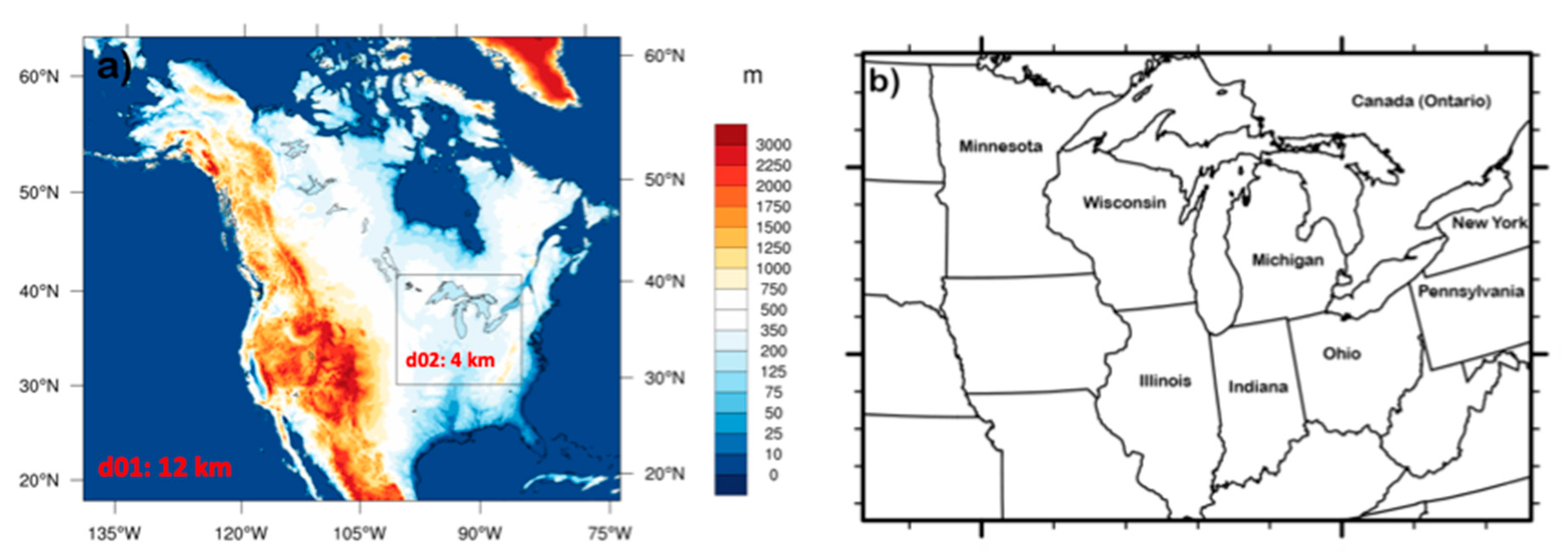

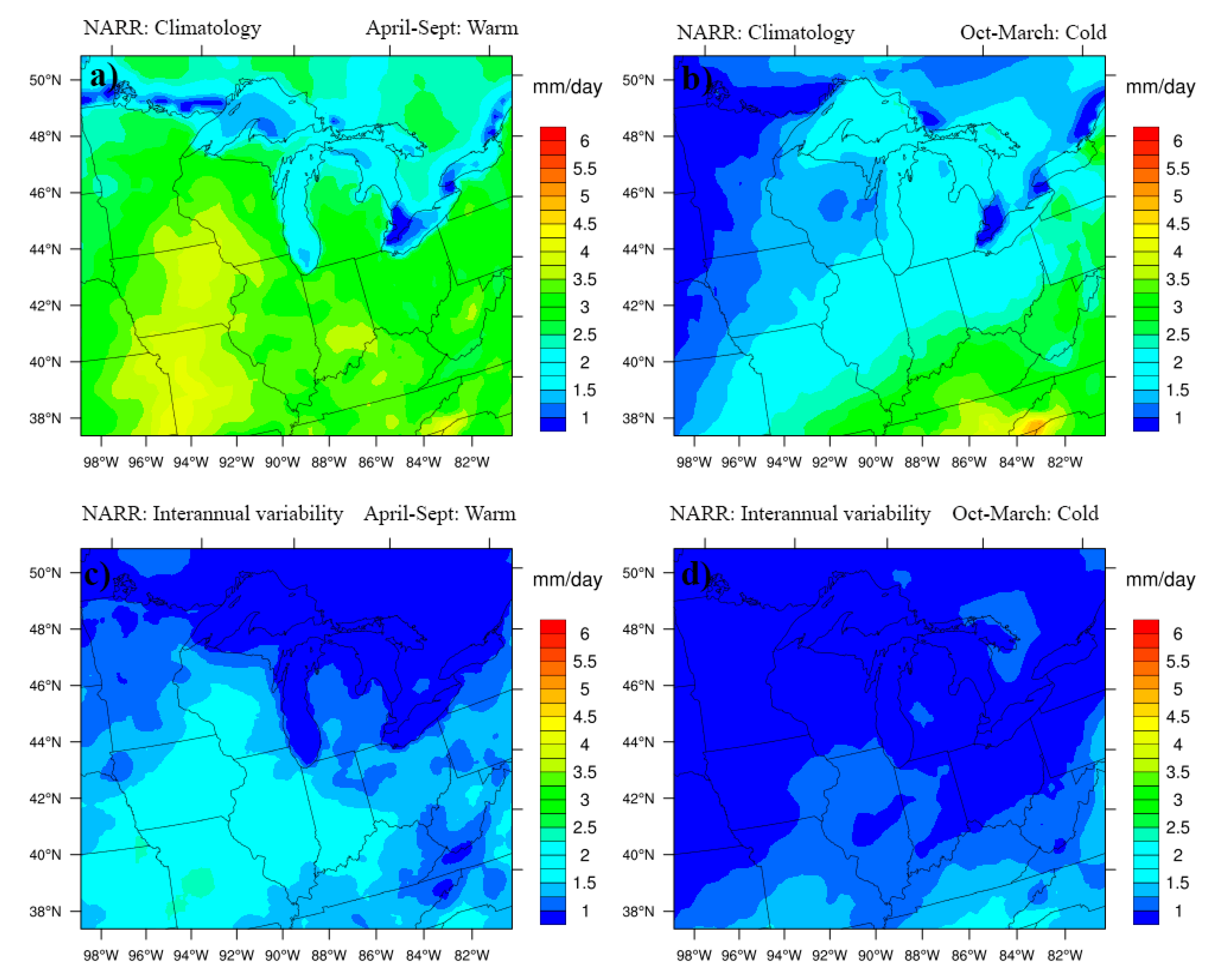
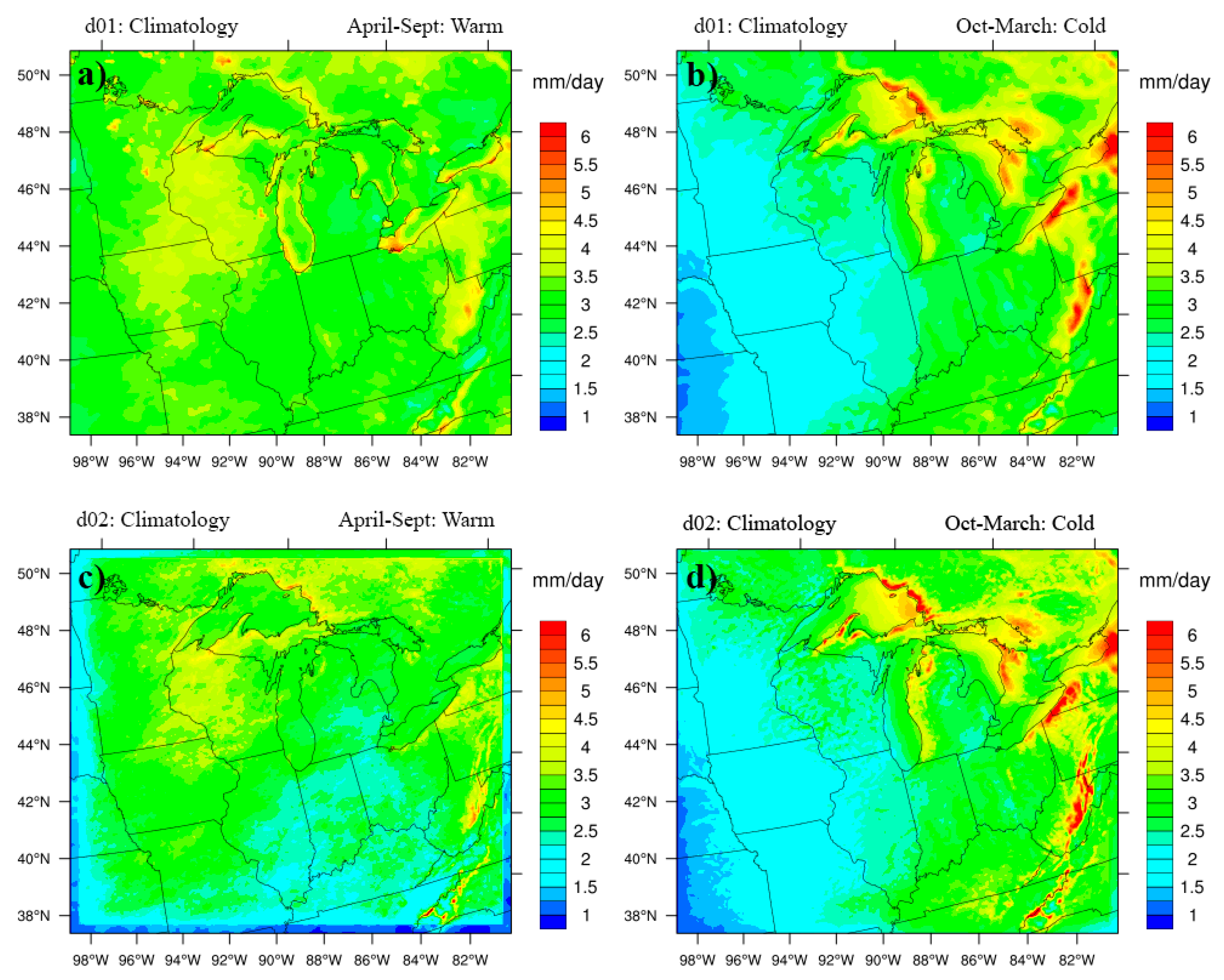

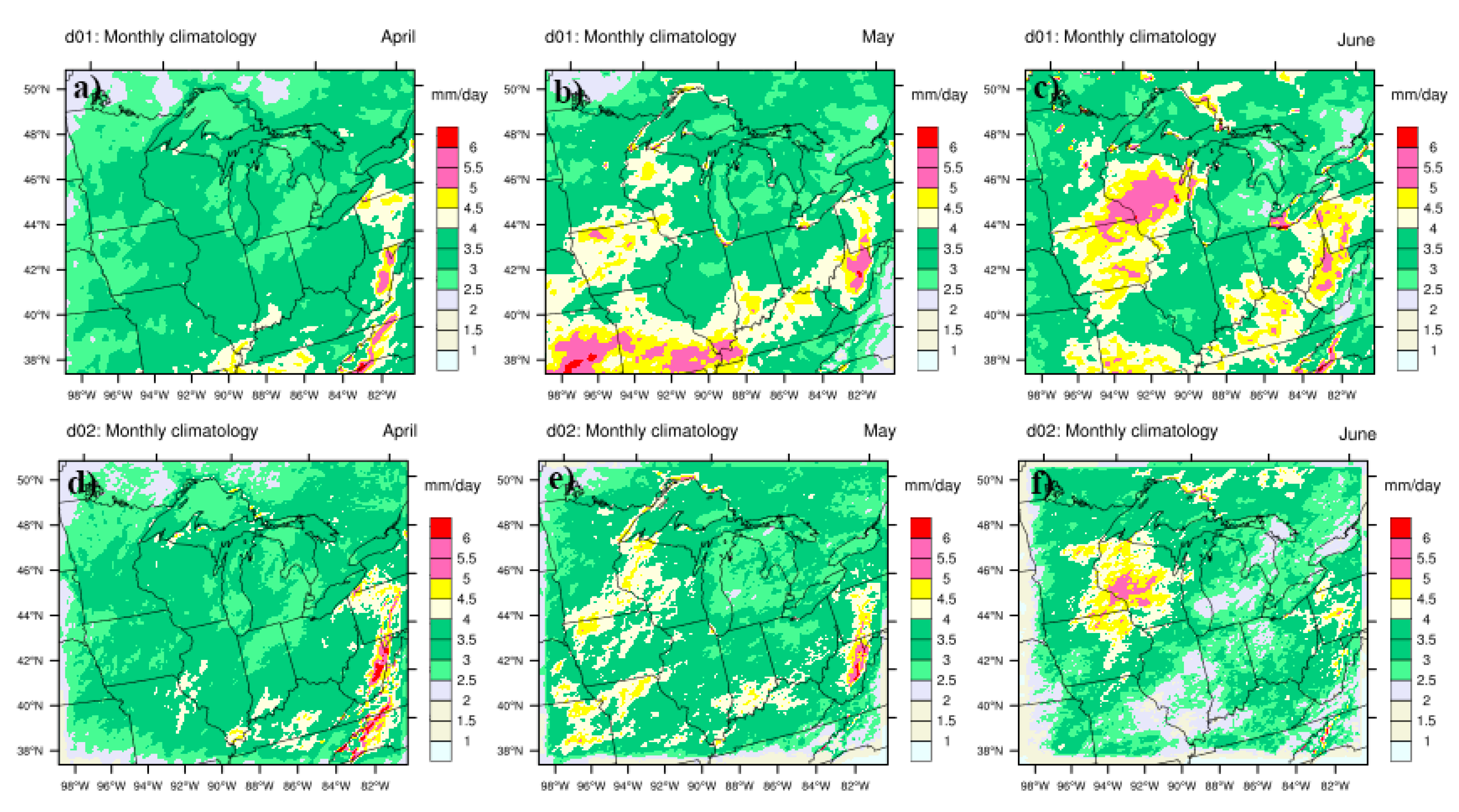
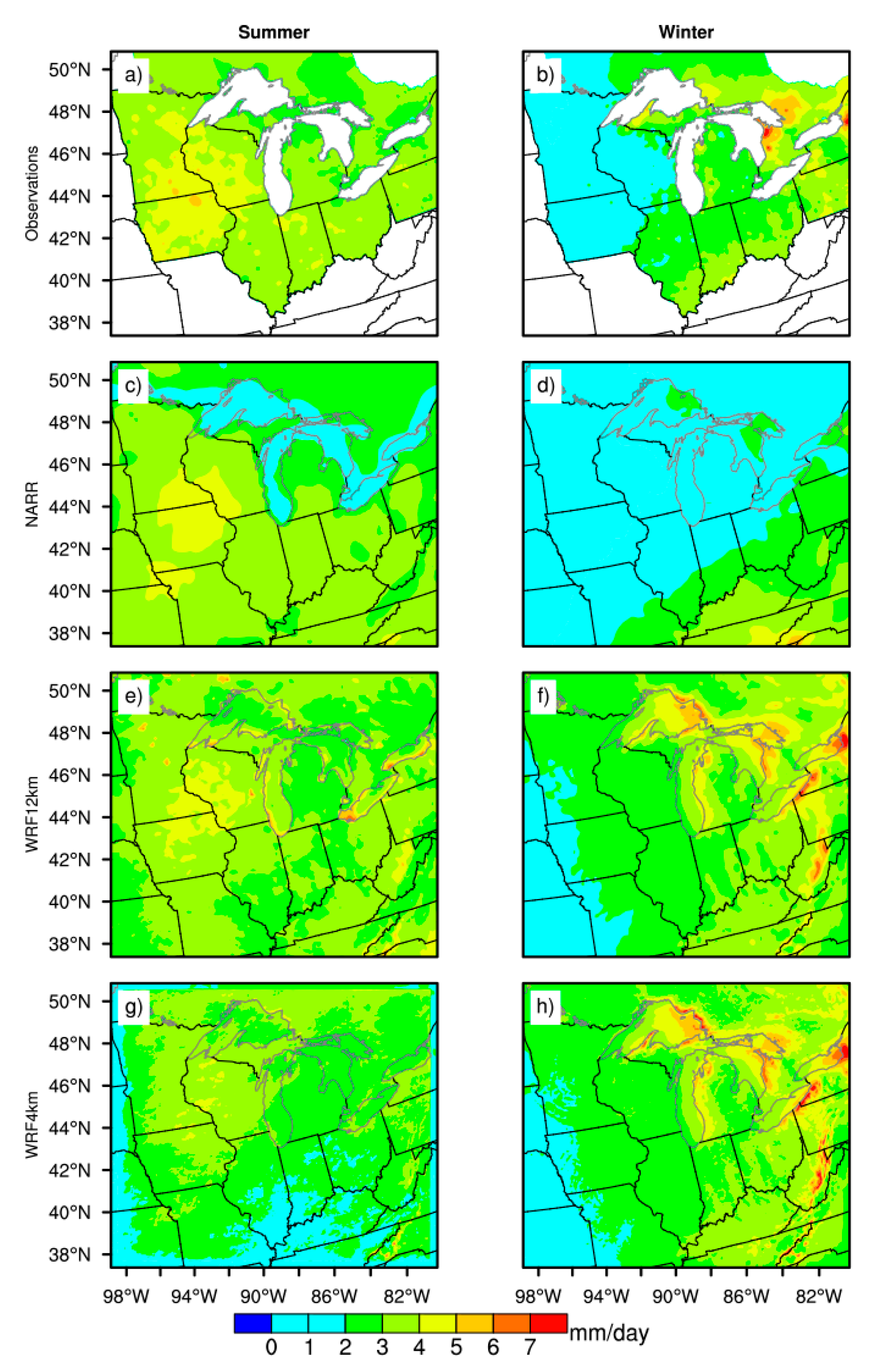
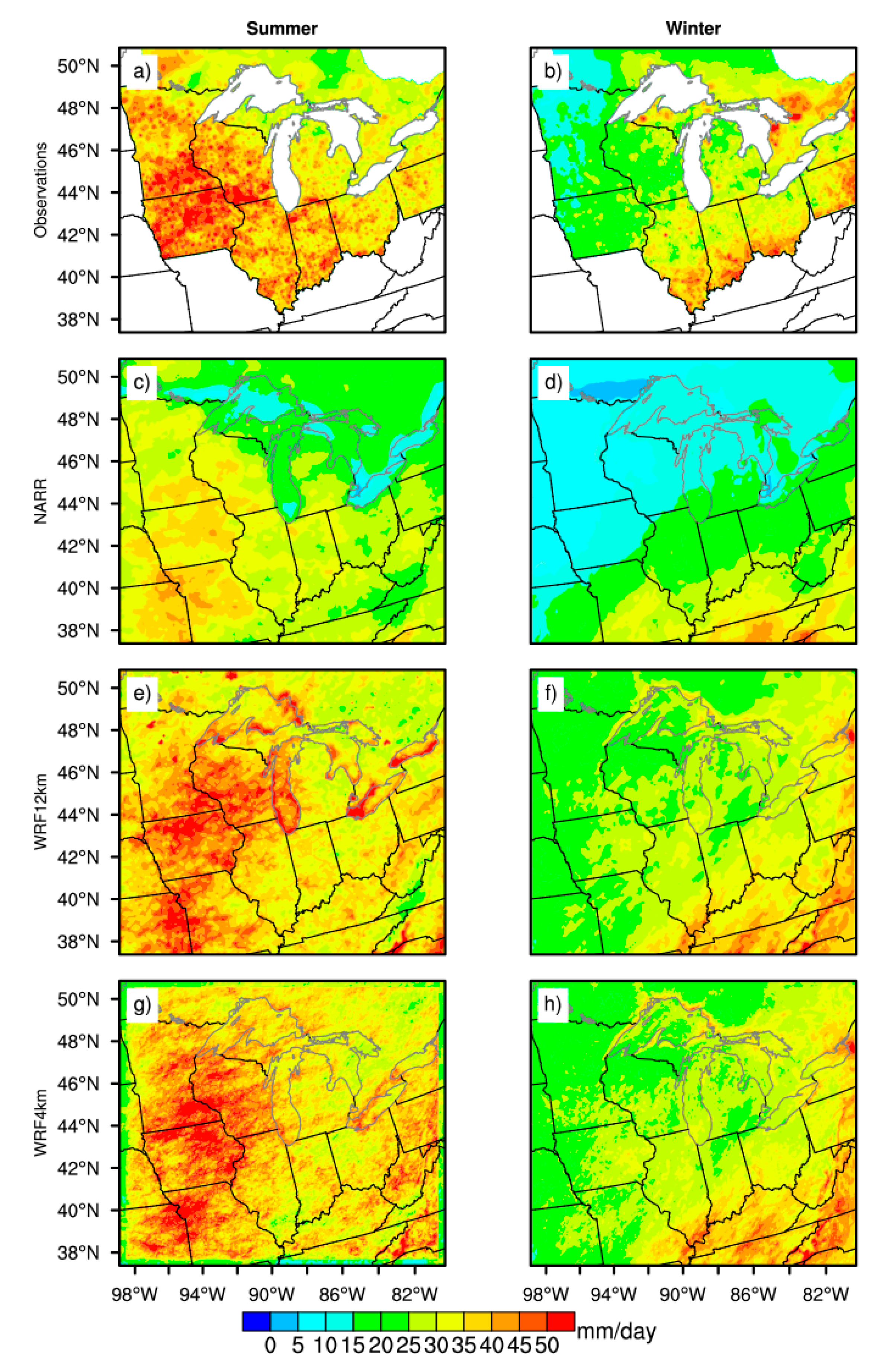

© 2019 by the authors. Licensee MDPI, Basel, Switzerland. This article is an open access article distributed under the terms and conditions of the Creative Commons Attribution (CC BY) license (http://creativecommons.org/licenses/by/4.0/).
Share and Cite
Sharma, A.; Hamlet, A.F.; Fernando, H.J.S. Lessons from Inter-Comparison of Decadal Climate Simulations and Observations for the Midwest U.S. and Great Lakes Region. Atmosphere 2019, 10, 266. https://doi.org/10.3390/atmos10050266
Sharma A, Hamlet AF, Fernando HJS. Lessons from Inter-Comparison of Decadal Climate Simulations and Observations for the Midwest U.S. and Great Lakes Region. Atmosphere. 2019; 10(5):266. https://doi.org/10.3390/atmos10050266
Chicago/Turabian StyleSharma, Ashish, Alan F. Hamlet, and Harindra J.S. Fernando. 2019. "Lessons from Inter-Comparison of Decadal Climate Simulations and Observations for the Midwest U.S. and Great Lakes Region" Atmosphere 10, no. 5: 266. https://doi.org/10.3390/atmos10050266
APA StyleSharma, A., Hamlet, A. F., & Fernando, H. J. S. (2019). Lessons from Inter-Comparison of Decadal Climate Simulations and Observations for the Midwest U.S. and Great Lakes Region. Atmosphere, 10(5), 266. https://doi.org/10.3390/atmos10050266





